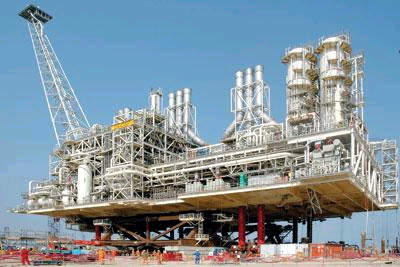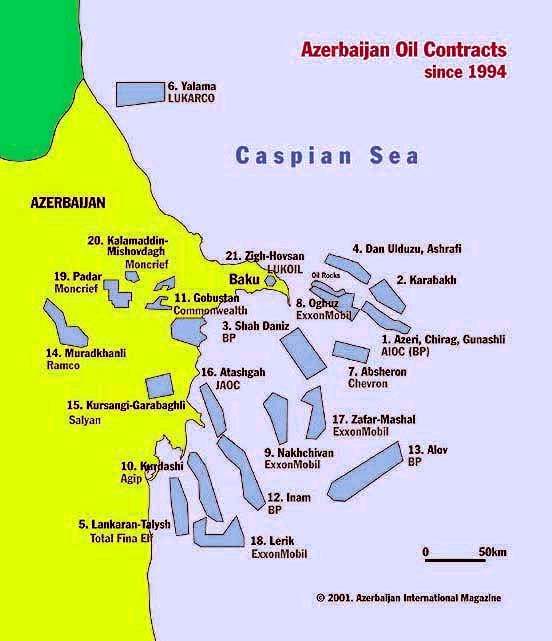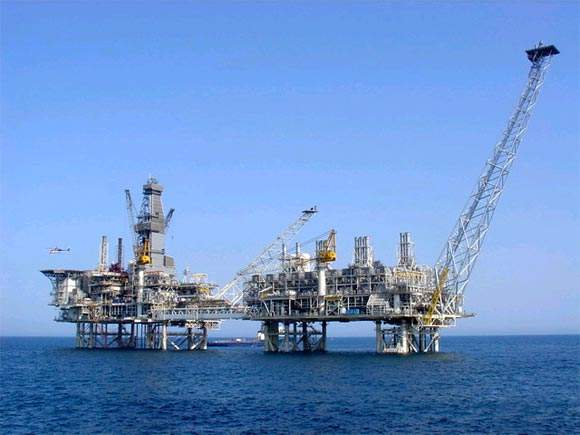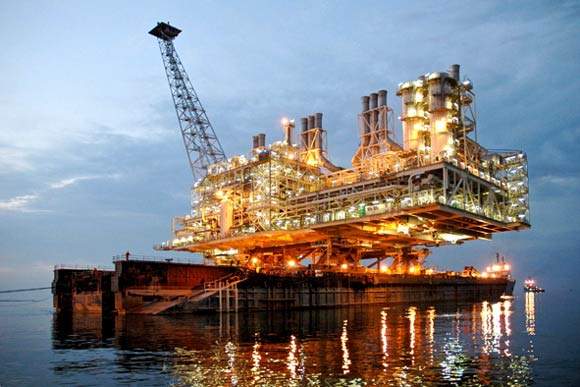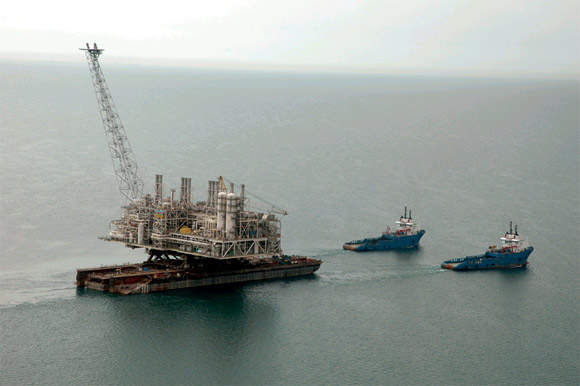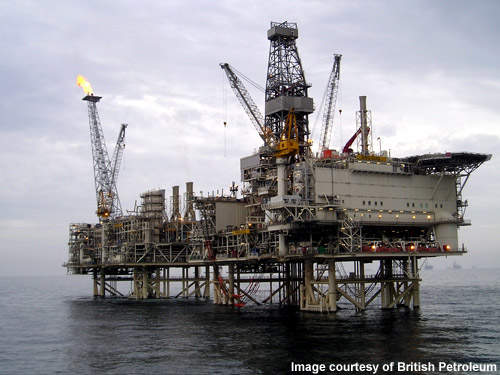The Azeri-Chirag-Gunashli (ACG) field lies 120km off the coast of Azerbaijan in 120m of water and contains 5.4 billion barrels of recoverable oil. The field was put into production in November 1997.
During the first six months of 2012, the field produced a total of 124.5 million barrels and 11.5 million cubic metres of associated gas per day from 56 production wells.
Participants of the ACG offshore field include: BP, which is operator with 35.83% stake; Chevron with 11.3%; SOCAR with 11.6%; INPEX with 11%; Statoil with 8.6%; ExxonMobil with 8%; TPAO with 6.8%; Itochu with 4.3%; and Hess with 2.7%.
In September 2012, ONGC Videsh Limited (OVL), an international arm of the Indian oil and gas company ONGC, signed an agreement to acquire Hess’s entire stake in the ACG project. The acquisition is subject to regulatory approvals is expected to be closed by 2013.
Chirag-1 platform
The Chirag early oil project (EOP) is a single offshore platform, producing over 125,000bpd. Production began in November 1997 and the field will reach the end of its productive life by 2024.
The Central, West and East Azeri complexes were developed under phases I and II, and the Deepwater Gunashli section was developed under phase III.
Chirag-1 is an offshore production, drilling and quarters (PDQ) platform located 120km east of Baku in the Caspian Sea. The Chirag facilities include a 24-slot PDQ platform with water-injection equipment, a 176km-long 24in oil pipeline to the receiving terminal at Sangachal, a 48km-long 16in gas pipeline to the oil rocks, a 12km-long 18in gas pipeline to Central Azeri, and a compression and water injection platform. The Chirag platform has both production and water-injection wells, which will increase oil recovery.
Crude comes ashore by pipeline to the Sangachal terminal south of Baku. Most is carried in the 850km western export pipeline which has a capacity of 140,000pd (peak 160,000) to the Georgian port of Supsa on the Black Sea. Some portions of the oil from Sangachal is also exported via a northern pipeline to the Russian Black Sea port of Novorossiysk. Tankers are used to ship the crude from Supsa and Novorossiysk.
Central Azeri platform
The Central Azeri is an offshore PDQ platform located in approximately 128m of water, 100km east of Baku in the Caspian Sea. The Central Azeri facilities include: a 48-slot PDQ platform; a 30in oil pipeline from Central Azeri to the Sangachal Terminal; a 28in gas pipeline from Central Azeri to the Sangachal Terminal; and the expansion of the existing onshore terminal at Sangachal.
Production from the Central Azeri field began in February 2005 under phase I of the development. This comprised two platforms built at the Amec-Tekfen-Azfen (ATA) yard, one for production and the other for compression and to provide water injection services to the Central, West and East Azeri platforms. The total capacity for the platform is 420,000bpd.
West Azeri platform
West Azeri came onstream in 118m of water in December 2005 with three predrilled wells. It is situated in 118m of water. The West Azeri facilities include a 48-slot PDQ platform and a 30in oil pipeline connecting to the expanded onshore Sangachal terminal.
Associated gas from West Azeri flows via subsea pipelines to a Central Azeri compression and water injection platform for reinjection to ensure pressure maintenance or to be used as fuel. Surplus gas will be exported to the Sangachal terminal.
East Azeri platform
East Azeri is an offshore 48-slot PDQ platform located 100km off the Baku coast in the Caspian Sea.
This platform has been in operation since 2006 with production capacity of 800,000bpd.
The Dada Gorgud completed the eight-well pre-drilling programme in December 2005. These are tied back to the platform once they are installed offshore.
The East Azeri topsides construction was carried out at the Baku Deepwater Jackets Factory (BDJF) yard, with all of the modules and the drilling derrick installed onto the integrated deck.
Gunashli field platform
Deepwater Gunashli (DWG) complex is the third phase of development of the ACG field in the Azerbaijan sector of the Caspian Sea. ACG field reserves expected to be produced during the PSA period are approximately 1.25 billion barrels.
The first oil from DWG complex was received on 20 April 2008. On plateau, the DWG complex will produce approximately 320,000bpd, thus bringing the total ACG production rate to a level of over a million barrels a day.
The DWG complex is located in a water depth of 175m on the east side of the Gunashli field. The complex comprises two bridge-linked platforms, a 48-slot drilling, utilities, and quarters (DUQ) platform, and a process, gas compression, water injection and utilities (PCWU) platform.
Production export off the complex is via two 30in oil pipeline tie-ins and a single 28in gas pipeline tie-in into pre-installed pipeline junctions located on the Azeri field subsea export pipelines to the onshore Sangachal terminal.
Uniquely, three subsea water injection wells have been installed in the DWG development. Production from DWG will be boosted by subsea water injection intended to ramp-up oil production by increasing pressure through injecting seawater into DWG reservoir.
Chirag Oil Project
In March 2010, a $6bn development plan was approved by the field partners for the Chirag Oil Project (COP). The project is aimed at recovering about 360 million barrels of oil and includes the installation of a new offshore platform. First oil from the COP is expected in late 2013.
Construction on the West Chirag platform started in July 2011 with the jacket completed in October 2012. The platform is expected to be commissioned in 2013.
Compression and water injection platform (CWP)
The bridge is linked to the Central Azeri platform. CWP provides water and gas injection services to the Central, West and East Azeri platforms. It manages associated gas export and provides electrical power using ten Rolls-Royce turbines.
The new platform will be a production, drilling and living quarters located at a sea depth of 170m. It will have a production capacity of 185,000bopd and will be partially integrated with the DWG complex.
Oil and gas exports: Baku-Tbilisi-Ceyhan (BTC) pipeline
The BTC pipeline carries only ACG oil and Shah Deniz condensate. In the future volumes will include those from the North Caspian.
BTC is a world-class pipeline that creates substantial revenues for the transit countries. It helps to strengthen economic and political links between Azerbaijan, Georgia, Turkey and the West.
The BTC shareholders are: BP (30.1%), AzBTC (25%), Chevron (8.9%), StatoilHydro (8.71%), TPAO (6.53%), ENI (5%), Total (5%), Itochu (3.4%), INPEX (2.5%), ConocoPhillips (2.5%) and Hess (2.36%).
A total of 326 million barrels of crude oil were exported from Ceyhan between 2006 and the first quarter of 2008. In the first quarter of 2008 the total volume of oil and condensate exported via BTC was about 62 million barrels. During the first half of 2012, the pipeline carried 129 million barrels of crude oil.
The pipeline celebrated the 400th cargo lifting from the Ceyhan Terminal in Turkey on 6 March 2008. About 453 tankers were loaded at Ceyhan with a total of about 356 million barrels (about 48 million tonnes) of crude oil transported via BTC and sent to world markets.
Contractors for the ACG oilfield
The front end engineering and design contract for COP was awarded to KBR in March 2009. In July 2010, BOS Shelf, a joint venture between Saipem and Socar, was awarded a $215m contract for fabrication of the jacket and subsea template of the new platform.
The ATA consortium consisting of AMEC, Tekfen Holding and Azfen won a $340m contract to provide fabrication, assembly, hook-up and commissioning services for the platform.
Kellogg Brown & Root won a $150m contract for engineering of the offshore infrastructure. Saipem was commissioned for transportation and installation of the subsea template under a $57m contract.
The living quarters of the platform will be fabricated by Apply Leirvik Emtunga under a $22m contract.
In November 2012, Aquaterra Energy won a contract to design and install centralisers at the West Chirag platform. A total 260 centralisers will be installed for the tie-back operations.

